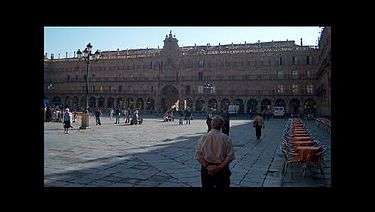Letterboxing (filming)
Letterboxing is the practice of transferring film shot in a widescreen aspect ratio to standard-width video formats while preserving the film's original aspect ratio. The resulting videographic image has mattes (black bars) above and below it; these mattes are part of the image (i.e., of each frame of the video signal). LBX or LTBX are the identifying abbreviations for films and images so formatted.

Early home video use
The first use of letterbox in consumer video appeared with the RCA Capacitance Electronic Disc (CED) videodisc format. Initially, letterboxing was limited to several key sequences of a film such as opening and closing credits, but was later used for entire films. The first fully letterboxed CED release was Amarcord in 1984, and several others followed including The Long Goodbye, Monty Python and the Holy Grail and The King of Hearts.[1] Each disc contains a label noting the use of "RCA's innovative wide-screen mastering technique."[2]
In cinema and home video
The term "SmileBox" is a registered trademark[3] used to describe a type of letterboxing for Cinerama films, such as on the Blu-ray release of How the West Was Won. The image is produced with 3D mapping technology to approximate a curved screen.
On television
Digital broadcasting allows 1.78:1 (16:9) widescreen format transmissions without losing resolution, and thus widescreen is becoming the television norm. Most television channels in Europe are broadcasting standard-definition programming in 16:9, while in the United States, these are downscaled to letterbox. When using a 4:3 television, it is possible to display such programming in either a letterbox format or in a 4:3 centre-cut format (where the edges of the picture are lost).
A letterboxed 14:9 compromise ratio was often broadcast in analogue transmissions in European countries making the transition from 4:3 to 16:9. In addition, recent years have seen an increase of "fake" 2.35:1 letterbox mattes on television to give the impression of a cinema film, often seen in adverts, trailers or television programmes such as Top Gear.[4]
Current high-definition television (HDTV) systems use video displays with a wider aspect ratio than older television sets, making it easier to accurately display widescreen films. In addition to films produced for the cinema, some television programming is produced in high definition and therefore widescreen.
On a widescreen television set, a 1.78:1 image fills the screen; however, 2.39:1 aspect ratio films are letterboxed with narrow mattes. Because the 1.85:1 aspect ratio does not match the 1.78:1 (16:9) aspect ratio of widescreen DVDs and high-definition video, slight letterboxing occurs. Usually, such matting of 1.85:1 film is eliminated to match the 1.78:1 aspect ratio in the DVD and HD image transference.
Letterbox mattes are not necessarily black. IBM has used blue mattes for many of their TV ads, yellow mattes in their "I am Superman" Lotus ads, and green mattes in ads about efficiency & environmental sustainability. Others uses of colored mattes appear in ads from Allstate, Aleve, and Kodak among others, and in music videos such as Zebrahead's Playmate of the Year. In other instances mattes are animated, such as in the music video for "Never Gonna Stop (The Red Red Kroovy)", and even parodied such as the final scene of the Crazy Frog Axel F music video in which Crazy Frog peeks over the matte on the lower edge of the screen with part of his hands overlapping the matte. Similar to breaking the border of a comic's panel, it is a form of breaking the fourth wall.
The table below shows which TV lines will contain picture information when letterbox pictures are displayed on either 4:3 or 16:9 screens.
| Aspect Ratio on 4:3 screen | 525 Line System | 625 Line System | Aspect Ratio on 16:9 screen | 525 Line System | 625 Line System | 1080 HD Line System | ||||||
|---|---|---|---|---|---|---|---|---|---|---|---|---|
| Full Screen (1.33:1) | 21-263 | 284-525 | 23-310 | 336-623 | - | - | - | - | - | - | - | |
| 14:9 (1.56:1) | 40-245 | 302-508 | 44-289 | 357-602 | - | - | - | - | - | - | - | |
| 16:9 (1.78:1) | 52-232 | 315-495 | 59-282 | 372-587 | Full Screen (1.78:1) | 21-263 | 284-525 | 23-310 | 336-623 | 21-560 | 584-1123 | |
| 1.85:1 | 56-229 | 320-491 | 64-270 | 376-582 | 1.85:1 | 26-257 | 289-520 | 29-304 | 342-617 | 31-549 | 594-1112 | |
| 2.35:1 | 73-209 | 336-472 | 85-248 | 398-561 | 2.35:1 | 50-231 | 313-495 | 58-275 | 371-588 | 86-494 | 649-1057 | |
Pillarboxing and windowboxing

Pillarboxing (reversed letterboxing) is the display of an image within a wider image frame by adding lateral mattes (vertical bars at the sides); for example, a 1.33:1 image has lateral mattes when displayed on a 16:9 aspect ratio television screen.
An alternative to pillarboxing is "tilt-and-scan" (reversed pan and scan), horizontally matting the original 1.33:1 television images to the 1.78:1 aspect ratio, which at any given moment crops part of the top and/or bottom of the frame, hence the need for the "tilt" component. A tilt is a camera move in which the camera tilts up or down.
Windowboxing occurs when an image appears centered in a television screen, with blank space on all four sides of the image,[5][6] such as when a widescreen image that has been previously letterboxed to fit 1.33:1 is then pillarboxed to fit 16:9. It is also called "matchbox", "gutterbox", and "postage stamp" display. This occurs on the DVD editions of the Star Trek films on a 4:3 television when the included widescreen documentaries show footage from the original television series. It is also seen in The Crocodile Hunter: Collision Course, which displays widescreen pillarboxing with 1.85:1 scenes in a 2.40:1 frame that is subsequently letterboxed. It is common to see windowboxed commercials on HD television networks, because many commercials are shot in 16:9 but distributed to networks in SD, letterboxed to fit 1.33:1.
Many 1980s 8-bit home computers feature gutterboxing display mode, because the TV screens normally used as monitors at that time tended to distort the image near the border of the screen to such an extent that text displayed in that area became illegible. Moreover, due to the overscanned nature of television video, the precise edges of the visible area of the screen varied from television set to television set, so characters near the expected border of the active screen area might be behind the bezel or off the edge of the screen. The Commodore 64, VIC-20, and Commodore 128 (in 40-column mode) featured coloured gutterboxing of the main text window, while the Atari 8-bit family featured a blue text window with a black border. The original IBM PC CGA display adapter was the same, and the monochrome MDA, the predecessor of the CGA, as well as the later EGA and VGA, also featured gutterboxing; this is also called underscanned video. The Fisher-Price PXL-2000 camcorder of the late 1980s recorded a windowboxed image to compensate partially for low resolution.
Occasionally, an image is deliberately windowboxed for stylistic effect; for example, the documentary-style sequence of the film Rent suggest an older-format camera representing the 4:3 aspect ratio, and the opening sequence of the Oliver Stone film JFK features pillar boxing to represent the 1960s era 4:3 television footage. The film Sneakers uses a windowboxing effect in a scene for dramatic effect.
See also
- Active Format Description
- Fullscreen (aspect ratio)
- List of film formats
- Motion picture terminology
References
- Haines, Richard W. (2003). The Moviegoing Experience, 1968–2001. North Carolina: McFarland & Company, Inc., Publishers. p. 139. ISBN 0-7864-1361-1. Retrieved 3 February 2016.
- "Amarcord CED Web Page". www.cedmagic.com. Retrieved 2019-08-16.
- "The Smilebox Story". Archived from the original on October 21, 2016. Retrieved January 9, 2010.
- "Televisual letterboxes", Image Dissectors.com, Archived from the original at the Wayback Machine URL accessed October 4, 2009
- "A visual reference to common Pixel Aspect formats". www.jeremymoore.com. Retrieved 2019-08-15.
- "Home Theater: Audio & Video Glossary - ACME HOW TO.com". www.acmehowto.com. Retrieved 2019-08-15.
External links
| Wikimedia Commons has media related to Letterboxing (film). |